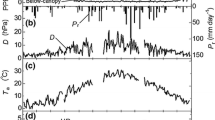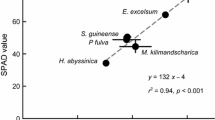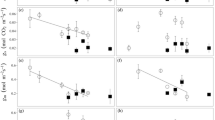Abstract
The relationship between photosynthetic capacity (A max) and leaf nitrogen concentration (N) among all C3 species can be described roughly with one general equation, yet within that overall pattern species groups or individual species may have markedly different A max-N relationships. To determine whether one or several predictive, fundamental A max-N relationships exist for temperate trees we measured A max, specific leaf area (SLA) and N in 22 broad-leaved deciduous and 9 needle-leaved evergreen tree species in Wisconsin, United States. For broad-leaved deciduous trees, mass-based A max was highly correlated with leaf N (r 2=0.75, P<0.001). For evergreen conifers, mass-based A max was also correlated with leaf N (r 2=0.59, P<0.001) and the slope of the regression (rate of increase of A max per unit increase in N) was lower (P<0.001) by two-thirds than in the broad-leaved species (1.9 vs. 6.4 μmol CO2 g−1 N s−1), consistent with predictions based on tropical rain forest trees of short vs. long leaf life-span. On an area basis, there was a strong A max-N correlation among deciduous species (r 2=0.78, P<0.001) and no correlation (r 2=0.03, P>0.25) in the evergreen conifers. Compared to deciduous trees at a common leaf N (mass or area basis), evergreen trees had lower A max and SLA. For all data pooled, both leaf N and A max on a mass basis were correlated (r 2=0.6) with SLA; in contrast, area-based leaf N scaled tightly with SLA (r 2=0.81), but area-based A max did not (r 2=0.06) because of low A max per unit N in the evergreen conifers. Multiple regression analysis of all data pooled showed that both N (mass or area basis) and SLA were significantly (P<0.001) related to A max on mass (r 2=0.80) and area (r 2=0.55) bases, respectively. These results provide further evidence that A max-N relationships are fundamentally different for ecologically distinct species groups with differing suites of foliage characteristics: species with long leaf life-spans and low SLA, whether broad-leaved or needle-leaved, tend to have lower A max per unit leaf N and a lower slope and higher intercept of the A max-N relation than do species with shorter leaf life-span and higher SLA. A single global A max-N equation overestimates and underestimates A max for temperate trees at the upper and lower end of their leaf N range, respectively. Users of A max-N relationships in modeling photosynthesis in different ecosystems should appreciate the strengths and limitations of regression equations based on different species groupings.
Similar content being viewed by others

References
Aber JD, Ollinger SV, Federer CA, Reich PB, Goulden ML, Kicklighter DW, Melillo JM, Lathrop RG Jr (1995a) Predicting the effects of climate change on water yield and forest production in the northeastern U.S. Climate Change (in press)
Aber JD, Reich PB, Goulden M (1995b). Extrapolating leaf CO2 exchange to the canopy: a generalized model of forest photosynthesis validated by eddy correlation. Oecologia (in press)
Chapin, FS III (1980) The mineral nutrition of wild plants. Annu Rev Ecol Syst 11:233–260
Chazdon RL, Field CB (1987) Determinants of photosynthetic capacity in six rainforest Piper species. Oecologia 73:222–230
DeLucia EH, Day TA, Vogelman TC (1992) Ultraviolet-B and visible light penetration into needles of two species of subalpine conifers during foliar development. Plant Cell Environ 15:921–929
Ellsworth DS, Reich PB (1993) Canopy structure and vertical patterns of photosynthesis and related leaf traits in a deciduous forest. Oecologia 96:169–178
Evans JR (1989) Photosynthesis and nitrogen relationships in leaves of C3 plants. Oecologia 78:9–19
Ferrari JB (1993) Spatial patterns of litterfall, nitrogen cycling and understory vegetation in a hemlock-hardwood forest. Ph.D. Dissertation, University of Minnesota
Field C, Mooney HA (1986) The photosynthesis-nitrogen relationship in wild plants. In: Givnish T (ed) On the economy of plant form and function. Cambridge University Press, pp 25–55
Gower ST, Son Y (1992) Differences in soil and leaf litterfall nitrogen dynamics for five forest plantations. Soil Sci Soc Am J 56:1959–1966
Gower ST, Reich PB, Son Y (1993) Canopy dynamics and above-ground production of five tree species with different leaf longevities. Tree Physiol 12:327–345
Kikuzawa K (1991) A cost-benefit analysis of leaf habit and leaf longevity of trees and their geographical pattern. Am Nat 138:1250–1263
Lloyd J, Syvertsen JP, Kriedemann PE, Farquhar GD (1992) Low conductances for CO2 diffusion from stomata to the sites of carboxylation in leaves of woody species. Plant Cell Environ 15:873–899
Pastor J, Aber JD, McClaugherty CA, Melillo JM (1984) Above-ground production and N and P cycling along a nitrogen mineralization gradient on Blackhawk Island, Wisconsin. Ecology 65:256–268
Reich PB (1993) Reconciling apparent discrepancies among studies relating life-span, structure and function of leaves in contrasting plant life forms and climates: “the blind men and the elephant retold”. Funct Ecol 7:721–725
Reich PB, Schoettle AW (1988) Role of phosphorus and nitrogen in photosynthetic and whole plant carbon gain and nutrientuse efficiency in eastern white pine. Oecologia 77:25–33
Reich PB, Walters MB (1994) Photosynthesis-nitrogen relations in Amazonian tree species. II. Variation in nitrogen vis-à-vis specific leaf area influences mass- and area-based expressions. Oecologia 97:73–81
Reich PB, Ellsworth DS, Kloeppel BD, Fownes JH, Gower ST (1990) Vertical variation in canopy structure and CO2 exchange of oak-maple forests: influence of ozone, nitrogen and other factors on simulated canopy carbon gain. Tree Physiol 7:329–345
Reich PB, Uhl C, Walters MB, Ellsworth DS (1991a) Leaf life-span as a determinant of leaf structure and function among 23 tree species in Amazonian forest communities. Oecologia 86:16–24
Reich PB, Walters MB, Ellsworth DS (1991b) Leaf age and season influence the relationships between leaf nitrogen, leaf mass per area, and photosynthesis in maple and oak trees. Plant Cell Environ 14:251–259
Reich PB, Walters MB, Ellsworth DS (1992) Leaf life-span in relation to leaf, plant and stand processes in diverse ecosystems. Ecol Monogr 62:365–392
Reich PB, Ellsworth DS, Walters MB, Uhl C (1994) Photosynthesis-nitrogen relations in Amazonian tree species. I. Patterns among species and communities. Oecologia 97:62–72
SAS (1994) JMP statistics and graphics guide, version 3. SAS Institute, Cary
Sprugel DG (1989) The relationship of evergreenness, crown architecture, and leaf size. Am Nat 133:465–479
Vitousek PM, Field CB, Matson PA (1990) Variation in foliar δ13C in Hawaiian Metrosideros polymorpha: a case of internal resistance? Oecologia 84:362–370
Walters MB, Field CB (1987) Photosynthesis light acclimation in two Piper species with different ecological amplitudes. Oecologia 72:449–456
Williams KC, Field CB, Mooney HA (1989) Relationships among leaf construction cost, leaf longevity, and light environment in rain forest plants of the genus Piper. Am Nat 133:198–211
Author information
Authors and Affiliations
Rights and permissions
About this article
Cite this article
Reich, P.B., Walters, M.B., Kloeppel, B.D. et al. Different photosynthesis-nitrogen relations in deciduous hardwood and evergreen coniferous tree species. Oecologia 104, 24–30 (1995). https://doi.org/10.1007/BF00365558
Received:
Accepted:
Issue Date:
DOI: https://doi.org/10.1007/BF00365558



